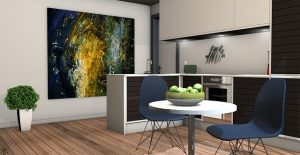Solving the Biggest Problems in Commercial Interior Design
Category : Arts
 One of the most significant keys for a business to become successful is its interior design.
One of the most significant keys for a business to become successful is its interior design.
Commercial interior design is a vital element in retail, office and industrial space design because of its numerous roles and functions.
Commercial interior design is vital
First of all, it helps attract and impress clients. Excellent interior design adds to the brand image of a company and plays a major role in the reputation and overall figure of a business. Commercial spaces that are appealing to potential clients are considered an added bonus to any industry. Retail stores see to it that they have areas perfectly designed to draw shoppers while hotels have definite stunning indispensable designs to showcase their services and amenities.
The best interior design also helps in optimizing lighting and space in any commercial rooms. An important requirement of interior design which initializes at the construction phase is providing adequate open spaces and equally sufficient lighting. An extra tip is to maximize the use of natural light and incorporate artificial light to supply the most efficient lighting results. Interior design also takes into account the future growth of the business. A business growth will entail an increase in manpower, workstations and other additional functions. Commercial interior design also provides the most appropriate plan to offer leisure to commercial entities. Establishing common areas such as lounges and canteens and making these areas comfortable and artistic is a primary responsibility of interior designers that results to boosting the esteem and experience of the people within the commercial space. Making sure that employees are happy in their workplace is as vital as making the customers satisfied and overwhelmed.
The industry of commercial interior design is fast growing basically because it is in demand by the business sector. However, the rising pace and dramatic change of this industry do not only bring more than a few benefits but also leads to several challenges.
Dealing within rapid turnovers
With today’s ever-developing communication technologies that allow workplaces to function at the click of a mouse, tap of a screen and touch of a button, businesses have definitely become more lucrative and efficient. However, this also means constant changing ways to deal with the rising expectation and growth in technology. The greatest challenge for interior designers is working within fast turnovers that result from meeting all of these demands to provide quality service. This can be addressed by putting more time into research, reflection and investigation. The preparation phase should not be taken for granted but given adequate consideration.
Adapting to technological change
It is essential to stay at the top of the game especially in connection with technology to win against competitors. It is not enough to be merely joining the craze; it should be dictating the trends and creating the buzz. This can be done by becoming a deliberate leader by organizing useful, significant and engaging content to existing clients and potential ones.
Consistently providing an excellent job
Even amidst all the advancement of technology and remarkable changes of the design process, the most important factor in commercial design is creating inspirational and exceptional designs. Stay focus and motivated in providing consistent great work because this is fundamentally the heart and core of a designer’s trade. In addition to providing excellent design, also highlight the significant aspects which are originality, honesty and integrity.
Being Multi-Skilled
Commercial interior design industry is growing pretty fast-paced and being in the competition will not work if the design company only highlights expertise, creative thinking and execution skills. The design company should utilize staff that has conventional artsy qualities and latest knowledge of technologies and related disciplines to establish a diverse and holistic approach to design.
Reviving personal interactions and promoting human experience
Never be influenced by the technology’s solution of being reliant to email and social media for communication because this one-dimensional way can result in a one-dimensional design that is far from being realistic and creative. Instead, make sure to discuss and brainstorm ideas habitually in person for an answer that ensures higher impact. Consumer experience should not become unclear because of technology but should depict and reflect modernization, narratives, and memories.
Creating a good “interior and health connection”
Interior design should not only focus on what is modern, striking and good-looking. It should also give consideration to health, environmental and sustainability concerns. The design must not be made with having the structure in mind alone. It should go far beyond taking into consideration the impact on the physical well-being, and emotional and mental health benefits of the people within the commercial space. Thus, there are already smart buildings that are designed to be sensitive, scalable, accessible, and health-oriented.
Dealing with hard to please clients
While this one may seem underdog compared to the previous challenges written above, it is the most universal. Having your patience tested recurrently and your professionalism destabilized is such a stressful experience to deal with. The solution to this dilemma is to stay calm, do not forget that you are a professional and act like one. This is largely effective even though it means taking lessons from clients who clearly do not have relevant knowledge about the subject, and giving in to their demands even if they are not the designs you would likely recommend. Gradually help them understand and guide them to the best decision because at the end of the day, while it may not always work to be as “customers are always right” but their words should always be final.
You may be a designer first, but you are also a business
Designers (and other creatives) cannot lose the fact that unless this is a hobby (unlikely) you are a business. As such you need to have a marketing and sales department or team, finance and administrative needs to be covered. Recruitment, payroll and staff issues need to be effectively addressed and of course the issues of effective and consistently well working IT. Design professionals cannot expect to wear every hat and should surround themselves with professionals to guide and support them in business, accounting, marketing and IT.
Written by Donna Stone – Artist & Blogger
Donna Stone is a business coach with three decades of experience. She grew her own business from a garage to be a multi award-winning operation that spanned five locations nationally. She shares this knowledge and expertise with clients to guide them in their own success. Donna works with business owners to help them build up their business with the view to selling it in – whether that be in 3 months’ time or 3 years’ time. Donna is a prolific blog writer, offering her blog writing services to business owners. She is also a five-times published author. Visit www.donna-stone.com.au.
